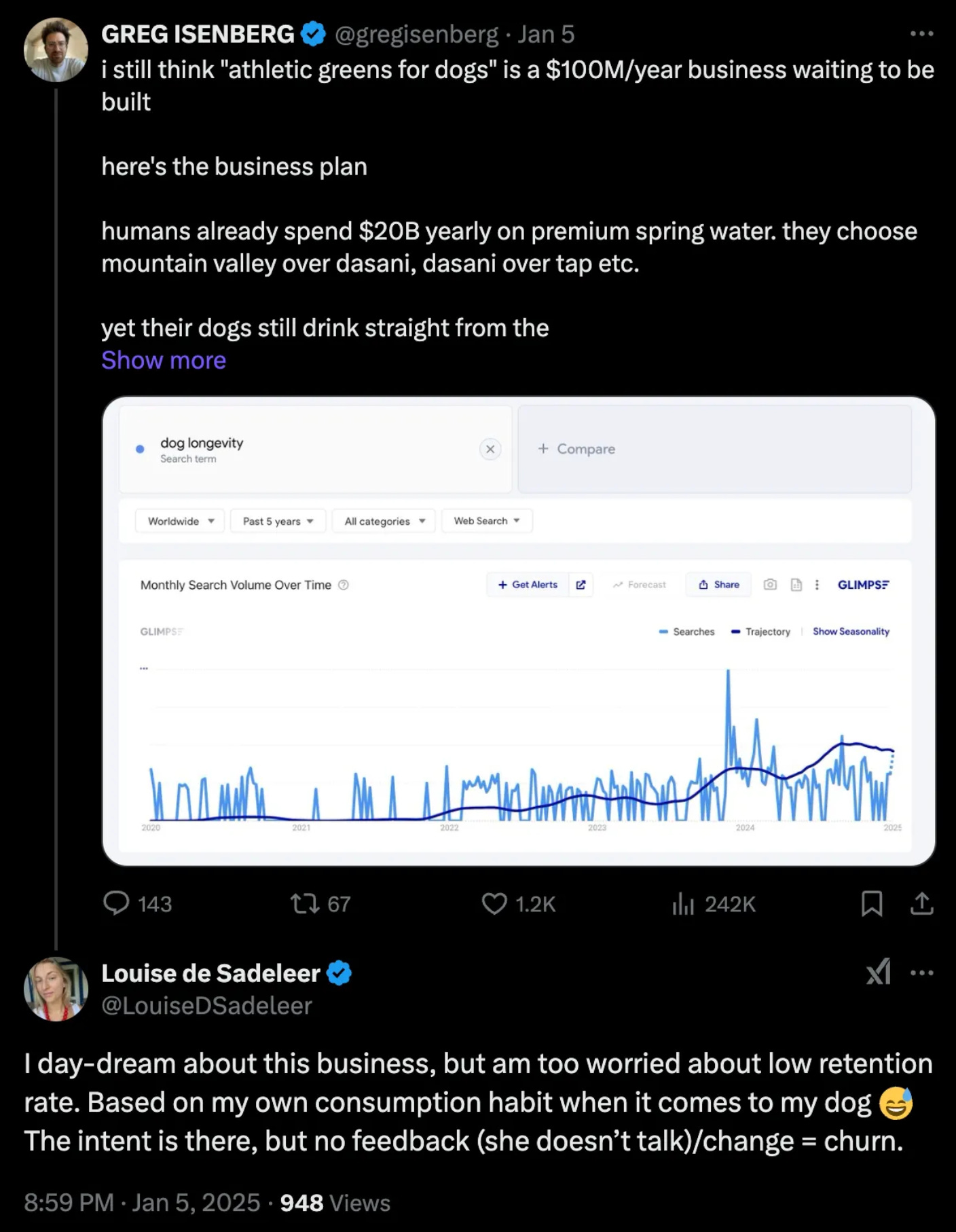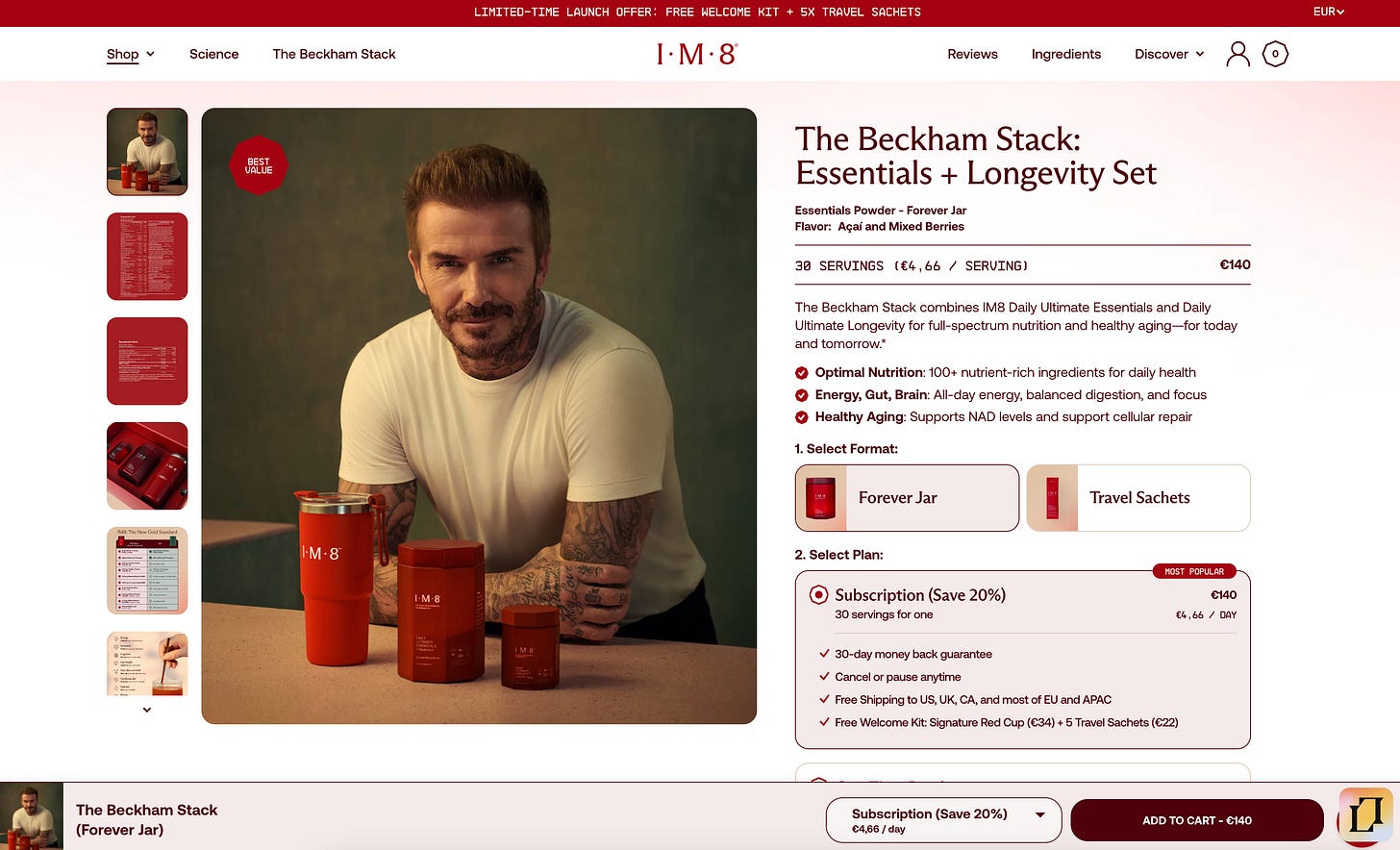my 2025 predictions for the consumer longevity industry
Read this if you're trying to live longer.
*I wrote this during a 17-hour fast, after a night of sleep that could have been even better (Oura score: 86%).
All of last year, I consulted on growth and marketing for InsideTracker— one of Andrew Huberman’s biggest podcast sponsors at the time.
You might know Huberman as Silicon Valley’s longevity darling. He is a neuroscientist and professor at Stanford University with 6M+ followers in Youtube.
Some of his most popular videos include ‘how & why to meditate’ and ‘grow bigger, stronger muscles’. The common thread? Multiple-hour-long educational videos on improving ‘longevity’.
The aim of longevity is to improve human (or animal) lifespan (# of years we live) and health span (# of healthy years). The longevity industry includes companies that focus on things like hormone health, sleep, and diet:
content/communities (e.g. Bryan Johnson’s “Don’t Die”)
hardware (e.g. Oura ring, WHOOP, Eight Sleep)
supplements (e.g. AG1, Thorne)
biotech innovations (e.g. Ozempic, CRISPR, gene therapy)
By 2030, the global longevity and anti-senescence therapy market is expected to grow to $44.2 billion, with a CAGR of 7.4%.
In this post, I’ll be sharing my 2025 predictions for the consumer longevity industry. Looking at it from the perspective of a marketer/founder/consumer.
Why now?
The past few years have seen a growing number of successful consumer-facing products targeted at longevity:
At-home testing kits versus needing to go to a lab— removed a big hurdle
Wide adoption of fitness trackers = new health data
DNA testing kits to detect probability of future disease (e.g. Alzheimer)
Supplements
We’ve also seen important scientific advancements speeding up longevity research and drug discovery:
AI for data analysis and machine learning
CRISPR for gene-editing
Various use cases for mRNA, GLP-1 (e.g. Ozempic)
As a marketer, working in longevity is a dream: there's potential for real impact on public health, educating new audiences, and a lot of money being invested.
Of course, we’re seeing a lot of snake oil, too. But that’s for some other time.
Predictions for consumer longevity in 2025
These 2025 predictions are based on my marketing work in the space and as a long-time consumer of longevity products. I’ll refrain from commenting too much on technologies that haven’t been commercialised yet.
1 — Products (blood biomarker tests, wearables, hardware)
For companies that sell blood biomarker tests like Function Health or InsideTracker, the player with the most strategic partnerships will win. Think insurance providers, healthcare providers, and corporate wellness programs.
Same is true for the one with the highest retention (MRR).
For expensive tests, branding matters a lot. They are still considered a luxury.
For now, distribution via influencer marketing and paid acquisition is still a solid strategy.
However, rising CAC due to competition and channel saturation will eventually make it near-impossible for DTC models to work. Today’s best performers have in-house influencers. Think of Function Health (Mark Hyman with 3.2M Instagram followers) and Blueprint (Bryan Johnson who released a Netflix documentary last week).
There will be replications of existing products, but for niches like female hormone health (see Muse Health or Guud) and sleep (Oura ring).
Niche hardware products will do well— air purifiers, LED lights, mattresses (e.g. Eight Sleep), continuous glucose monitors, wearable trackers.
Declining costs in hardware, means there will be more wearable products offered at lower price points or with no upfront cost, but with a subscription instead (e.g. WHOOP or Maven Pet).
Eventually, innovation/value in these wearable devices will hit a ceiling. More features = frequent charging. Progress will follow advancements in microchip technology and battery capacity.
2 — New and growing markets
Companies like Loyal (raised more than $125 million since 2019) are studying longevity in dogs. Their short lifespans may mean we’ll get interesting insights into human longevity sooner rather than later.
Conversely, there will be replication of tried and tested ‘for-human’ products for pets (e.g. Modern Animal, 24/7 virtual veterinary care).
The other day Greg Isenberg mentioned someone should build the “Athletic Greens for pets”. Here’s what I think.
As always, the biggest winners will be the platforms and tools that enable innovation— just like NVIDIA did for semiconductor manufacturing. One example is Gingko Bioworks (biopharma manufacturing).
Influencers will continue to launch not-so-innovative-yet-harmless supplements. Think anti-glucose spike supplements by Glucose Goddess or this anti-aging “Beckham Stack” for €144/month.
3 — Biotech and drug discovery
Of course, real disruption will only come from companies like General Proximity or Isomorphic Labs (by Google Deepmind CEO and Nobel Laureate, Demis Hassabiss). These companies have a strong thesis, backed by years of research.
Regulation and money for R&D are the biggest factors for success here. Their job is to market to VC’s and regulators. No need for consumer marketing just yet.
Silicon Valley will continue to invest in biotech (prominent investors include Jeff Bezos, Peter Thiel, Zuckerberg, Larry Ellison, and Sam Altman).
We’ll start to see the fruit of AI in biotech innovation. Machine learning will continue to be used for faster drug discovery, image data labeling, and even virtual clinical care.
4 — Marketing and influencers
Science influencers like Huberman will continue to make well into the 6 figures off longevity startups. They can ask premium rates, essentially skimming off most of a company’s profit.
Influencers won’t even need to launch their own products, but can always change their mind.
For supplements like Thorne, it will become a game of ‘best brand, biggest ad/influencer budget’. Although, I suspect AG1 might have taught us to become more skeptical.
‘Cool kid’ longevity start-ups will realise they need move beyond 25 to 30-year-olds working in tech and start marketing to older millennials and baby boomers. You know, people who actually need their products.
The oldest Millennials are turning 44 this year. This is considered middle-aged, and happens to be when fear of death peaks, according to research.
The most sought-after audience for marketers in longevity will be older millennial listeners of podcasts like The Huberman Lab or Chris Williamson.
Bryan Johnson from ‘Don’t Die’ will go Elon Musk-level mainstream. His Netflix documentary might have been exactly what he needed to convert older demographics.
Johnson will continue to demonstrate his impressive PR dance around controversy and ethics. Marketers take note.
Maybe, we’ll see non-longevity companies embrace the longevity angle in campaigns. I would do this if I were Loop Earplugs (e.g. “this person is 18, but her ears are 47”).
5 — Consumer habits and sentiment
We will see a dichotomy between increased ‘productivity fatigue’ resulting in people rebelling and the highest number sober-curious consumers in a while.
The rich will travel to places like Próspera in Honduras for experimental therapies like young blood transfusion, HBOT, and eventually stem cell therapy. Living longer will become the ultimate luxury.
People will become more educated on basic biology concepts (e.g. Athletic Greens contain too little % of each supplement to be impactful).
More politics. We’ll see topics like longevity, access to health, gene-editing, big Pharma become more politicised than ever. Mirroring the reaction to the murder of UnitedHealth Group CEO, Brian Thompson.
The impact of GLP-1 (e.g. Ozempic) on humanity will be comparable to that of AI. Commercialisation at scale of similar drugs will bring obesity to an all-time low. Maybe, it’s already happening?
What I’d like to see
Disruptions in prominent disease reversal or slowing (e.g. HIV, cancer). I know this hits close to home for a lot of us.
For longevity startups to focus on more pressing demographics (chronic pain, elderly population). We’re seeing early adopters (tech bros) optimise the final 10% of their health. I’d like to see successful marketing toward less educated audiences.
Faster, virtual diagnosis of things like skin cancer, heart attacks, diabetes.
An all-time low in obesity would pretty cool, too.
Lastly, I’ll leave you with this contrarian take on longevity by Musk. What do you think?
This post took me a lot of time to write. If you liked it, consider subscribing to this newsletter. Or sharing this post with someone who might like it 🫶
Talk soon,
Louise













